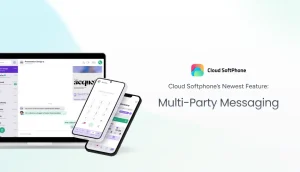
Build a white label softphone app
Create a custom white-label softphone with Cloud Softphone.
- No devs needed
- Native desktop apps
- 100+ premium features

2024 was a big year for the telecom sector. This year’s shaping up to be even bigger.
From artificial intelligence and regulatory challenges to Wi-Fi 7 and 6G, here are seven ways we expect the telecom industry to evolve in 2025.
Unsurprisingly, artificial intelligence remains both the most significant innovation driver and the biggest disruptive force in telecommunications. Over the past few years, AI technology has completely reshaped telecom operations. This evolution will continue in 2025 as adoption increases, with major innovations and talking points including:
Through artificial intelligence, network operators can not only modernize how networks are managed and operated, but also how they’re designed. From automated, dynamic resourcing and traffic routing to predictive fault detection and maintenance, AI-driven networks are not only more cost-effective, but also more reliable and responsive. What we’ve seen thus far, however, is only the beginning.
The next step? Full automation. Picture an intelligent, autonomous network where human intervention is only required for hardware maintenance.
Would you believe it’s already happened? Starting in September 2024, Beijing’s Tsinghua University
It’s closer to happening than you might think. Near the end of 2024, Beijing’s Tsinghua University launched the world’s first Level 4 autonomous network. Telecom provider China Mobile also reportedly intends to begin a three-year program culminating in the launch of an L4 network in China’s Guangdong province.
Given how the current AI boom more or less began with ChatGPT, it’s hardly surprising that customer service has been a major benefactor of the technology. In addition to being capable of tackling low-level customer support, AI can drive deeper personalization and help support teams operate more efficiently. Again, though, what we’ve seen so far is only the beginning.
You might remember how, in September, T-Mobile announced a major collaboration with Nokia, Ericsson and Nvidia, intending to establish the industry’s first innovation center for AI-RAN technology. There was also another announcement, just as exciting, that was a bit overshadowed, however. T-Mobile also announced that it was collaborating with OpenAI to develop IntentCX, an “intent-driven AI decisioning platform” trained on billions of customer interactions — and set to launch this year.
It’s no secret that telecommunications providers spend a ton of time and money on back office administration. Most businesses do. But AI has the potential to change that, simultaneously reducing overhead and enhancing revenue by allowing employees to offload repetitive manual tasks and focus their attention on more productive, valuable work.
AI is also an incredible productivity tool. Rather than replacing humans, it empowers them, assisting in everything from brainstorming and content ideation to scheduling and transcribing meetings. More companies in the telecom space realize this by the day, meaning adoption will inevitably increase through 2025.
It’s not all smooth sailing for artificial intelligence. Regulation is still a significant stumbling point for the technology, with many governments lacking a tangible framework for the technology. Even the European Union, historically a trailblazer where technology legislation’s concerned, has been accused of dragging its feet.
The good news is that these are the same growing pains we see with every new technology. While we might not see a resolution in 2025, the law will eventually catch up. In the meantime, the best thing we can do is wait.
Arguably more pressing is the ongoing AI talent shortage. There simply aren’t enough people with the necessary skills to effectively leverage the technology. We already saw organizations ramping up their training programs in 2024 — this trend’s likely to continue into the coming year, with businesses potentially even using AI to train people on AI.

One of the biggest changes to the telecom sector in 2025 is expected to come from the White House. The Trump administration has promised to make a number of sweeping changes to telecom regulations. More specifically, pending Federal Communications Commission (FCC) Chair Brendan Carr has promised to eliminate the “heavy-handed regulations” of the Biden administration.
Although we still don’t have the specifics on what that entails, at the very least we’re likely going to see changes to legislation around net neutrality, mergers and acquisitions, and cybersecurity.
In 2024, we saw another major update to wireless networking standards with the release of Wi-Fi 7. Compared to Wi-Fi 6, it supports more connections, and offers improved speed and adaptability. It also introduces multi-link operation, which allows a device to connect to a router across multiple bands.
Initially, the new standard was only available on specialized — and prohibitively expensive — networking hardware. Toward the end of 2024, however, more affordable routers began to hit store shelves. Through 2025, Wi-Fi 7 devices will become both more cost-effective and more widespread, particularly as more end-user devices release with Wi-Fi 7 support.
China started 2024 off with a bang by announcing that it had developed the next generation of mobile networking technology. Well, sort of. Created through a collaboration between Huawei Technologies and China Unicom and based on communication standards released by 3GPP in 2021, 5.5G offers data speeds of up to 10 gigabits per second to 5G’s 1 gigabit per second.
Research into 6G technology also progressed a great deal in 2024, with the National Telecommunication and Information Administration announcing earlier this month that it’s been actively involved in supporting the new standard’s development. It also detailed a report from the Commerce Spectrum Management Advisory Committee (CSMAC) with a more defined idea of what 6G will look like. Notable features include intelligent communications, dynamic connectivity, and a greater focus on digital equity, security, and public safety.
In other words, 6G is finally starting to take form, and will likely continue to become more well-defined this year — though we aren’t likely to see an implementable standard until at least 2029.
Imagine a world where no matter where you went, you’d have access to high-speed Internet. We’re closer than ever to such a world becoming reality. Telecom companies are increasingly looking to the stars as the next frontier for connectivity, supported by technologies such as Low Earth Orbit (LEO) satellite constellations.
Consisting of between five hundred and several thousand small satellites, these distributed satellite networks are potentially capable of providing high-bandwidth, low-latency Internet to virtually any location in the world. Not only does this mean underserved rural areas could soon have access to high-speed Internet, it could also prove invaluable in keeping first responders connected during emergencies.
As telecommunications networks grow perpetually larger and more distributed, traditional centralized infrastructure becomes progressively less feasible. Processing at the network’s edge is well on its way to becoming the norm. Similarly, cloud-native billing and customer management systems and cloud-native operational support systems are replacing more traditional, hardware-based options.
Experts such as Ciena Blue Planet Vice President of Portfolio and Engineering Kailem Anderson feel this transition is as essential as it is inevitable.
“Legacy systems just can’t provide the elasticity, scale, flexibility and programmability that’s needed to deliver [services] as demanded…The shift is happening right now,” Anderson explained in an October 2024 interview with Fierce Network. “And the reality is telcos, they’ve adopted cloud due to its benefits, simplicity, ability to turn up, tear down and scale out on demand. So, the natural evolution of this is OSS being cloud-native, so you can reap the benefits of the cloud, just beyond traditional lifting and shifting and containerization.”
The smart city has been a hot topic for more than half a decade, and it’s not hard to see why. The notion of a hyperconnected city where everything from transportation to the power grid is automatically and intelligently managed is an attractive one. But historically, it’s also been largely out of reach.
Until now, at least.
Over the past few years, multiple cities around the world have begun adopting a wide range of smart technology, collaborating with telecom companies to deploy IoT-focused infrastructure across multiple public works. Singapore is currently at the top of the list, with innovations ranging from smart grid management to sensors that allow the city to tell how crowded or clean certain areas are. It’s also planning to develop a completely vehicle-free smart forest city with five districts and 42,000 houses.
There’s also Oslo, which has plans for all of its vehicles to be fully electric by the end of this year.
It’s going to be an exciting year for the telecom sector, one full of both innovation and opportunity.
But what can you do to prepare? A few things.
First, consider investing in software-defined networking technology and assessing your AI readiness. Exploring partnerships with complementary vendors, such as streaming services and content providers, may also be worthwhile. Finally, embrace cybersecurity best practices such as zero trust and multi-factor authentication as the default.
Take the next step with a proven partner. Acrobits has been driving telco innovation from the beginning. Curious? Our sales team is just a call away.
There are big things coming in 2025 — and we can’t wait to see what that means for 2026.

There’s no denying AI is making inroads in almost every part of business. But what happens when it comes to customer service? AI is transforming how businesses interact with their customers by automating repetitive tasks, analyzing data in real-time, and enabling personalized experiences at scale. From chatbots that resolve issues instantly to predictive algorithms that […]

Within an organization, teams and departments typically develop their own bonds and their own ways of communicating. But what happens when people from various business functions are brought together for a specific project? There are many advantages to cross-functional teams, which combine skills and resources to move projects forward and solve problems creatively. But the […]

TLDR: As MaX UC reaches it’s end-of-life, providers must decide between brand control, simplicity, or cost savings. Options include: Microsoft Teams for stability Cloud Softphone for flexibility and independence Or a reseller path for low-cost operations Each path comes with unique trade-offs in branding, customization, and long-term growth potential. Choose based on your priorities: fast […]

At Acrobits, we’ve never been good at standing still. Ever since we developed the first mobile VoIP application to appear on iTunes and Google Play, we’ve been looking for new ways to enhance our customer offerings. Always with One Goal in Mind Creating new opportunities to make our applications more compelling and the user experience […]